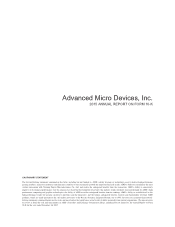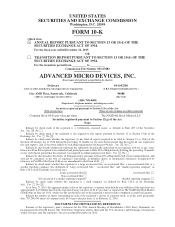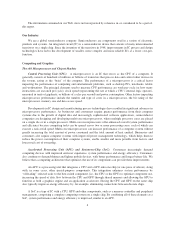AMD 2015 Annual Report Download - page 14
Download and view the complete annual report
Please find page 14 of the 2015 AMD annual report below. You can navigate through the pages in the report by either clicking on the pages listed below, or by using the keyword search tool below to find specific information within the annual report.computational problems in disciplines ranging from financial modeling to weather forecasting to oil and gas
exploration. Servers are also used in cloud computing, which is a computing model where data, applications and
services are delivered over the internet or an intranet. Today’s data centers require new technologies and
configuration models to meet the demand driven by the staggering amount of data that needs to be stored,
accessed and managed. Servers must be efficient, scalable and adaptable to meet the compute characteristics of
new and changing workloads.
Embedded.Embedded products address computing needs in PC-adjacent markets, such as industrial
control and automation, digital signage, point-of-sale/self-service kiosks, medical imaging, set-top box and
casino gaming machines as well as enterprise class telecommunications, networking, security, storage systems
and thin clients (which are computers that serve as an access device on a network). Typically, our embedded
products are used in applications that require high to moderate levels of performance, where key features may
include mobility, relatively low power, small form factor, and 24x7 operations. High-performance graphics are
increasingly important in many embedded systems. Support for Linux®, Windows®and other operating systems
as well as for increasingly sophisticated applications are also critical for some customers. Other requirements
may include meeting rigid specifications for industrial temperatures, shock, vibration and reliability. The
embedded market has moved from developing proprietary, custom designs to leveraging industry-standard
instruction set architectures and processors as a way to help reduce costs and speed time to market.
Semi-Custom.We have leveraged our core IP, including our graphics and processing technologies
developed for the PC and server markets, to develop semi-custom solutions for customers who want
differentiation in their products. In this market, semiconductor suppliers work alongside system designers and
manufacturers to enhance the performance and overall user experience for semi-custom customers. AMD has
used this type of collaborative development approach with today’s leading game console manufacturers, and can
also address customer needs in many other markets beyond game consoles, leveraging our existing IP to create a
variety of products tailored to a specific customer’s needs, ranging from complex fully-customized SoCs to more
modest adaptations and integrations of existing CPU, APU or GPU products.
Our Enterprise, Embedded and Semi-Custom Products
Server Processors. Our microprocessors for server platforms currently include the AMD Opteron™ X-
Series, AMD Opteron™ 6300 Series processors, and AMD Opteron™ A-Series processors. In January 2016, we
launched the AMD Opteron™ A1100 SoC, our first 64-bit ARM®based product, designed to accelerate time-to-
market deployment of ARM-based systems for the datacenter and improve enterprise-class ecosystem support for
64-bit ARM in key markets.
Embedded Processors. Our embedded processors are increasingly driving intelligence into new areas of
our lives, like interactive digital signage, casino gaming, and medical imaging devices. These products are
designed to support greater connectivity and productivity, and we believe they are a strong driver for the
“internet of things” and “surround computing” areas in the computing industry. Our processor products for
embedded platforms include AMD Embedded R-Series APU and CPUs, AMD Embedded G-Series SoC platform
and AMD Embedded Radeon™ GPUs. In September 2015, we announced multiple new discrete AMD
Embedded Radeon graphics cards, the AMD Embedded Radeon™ E8950MXM Module, the Embedded
Radeon™ E8870 Series and E6465 Series, suitable for multiple form factors. The suite of products is specifically
designed to advance the visual and parallel processing capabilities of embedded applications. In October 2015,
we announced new AMD Embedded R-Series SOC processors designed for a broad variety of embedded
applications. The processors incorporate the newest AMD 64-bit x86 CPU core (“Excavator”), plus third-
generation Graphics Core Next GPU architecture, and power management to minimize energy consumption.
Dense Server Systems. As part of our strategy to simplify and sharpen our investment focus, we decided
in the first quarter of 2015 to exit the dense server systems business, formerly SeaMicro. AMD continues to
provide warranty and extended support to the existing installed base of SeaMicro dense server systems, but is no
longer selling dense server systems or offering additional extended support.
8
























